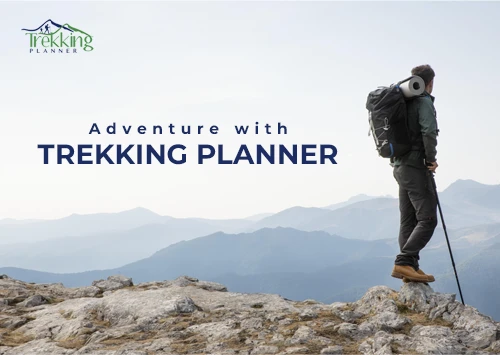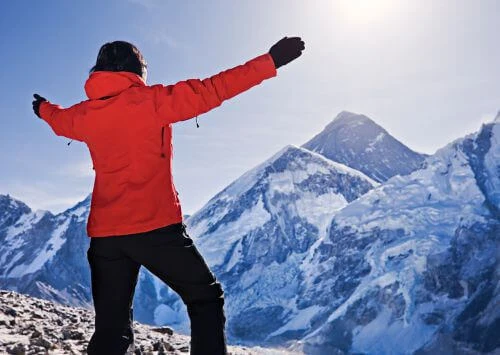Everest Region Trekking
Everest (also known as Sagarmatha) is a hot spot for adventure and culture. Each year, thousands of trekkers make the trek to Everest Base Camp; those willing to push their limits further can climb to its summit for an unforgettable journey.
This UNESCO World Heritage Site offers breathtaking natural beauty, from lush forests and alpine meadows to barren, snow-covered slopes above the tree lines. Additionally, this area provides vital habitat for endangered wildlife like Himalayan tigers and snow leopards, yet tourism and mountaineering continue to threaten this fragile environment.
Culture is of equal significance in this region. Home to the Sherpa people, renowned for their hardiness and endurance, their villages, dot valleys, monasteries, and museums are dedicated to their history and traditions.
Visits to the Khumbu Glacier and trekking through its treacherous Ice Fall, with its vast fallen ice blocks and crevasses posing an extraordinary climbing challenge, are essential. In addition, this region is famed for its spectacular sunrises and sunsets, which paint the skies with golden hues reflecting off glaciers and towering peaks—truly magnificent sights indeed!
Although many travelers visit this region for mountaineering, trekking is also a very popular activity. There are a number of challenging treks, and one particularly legendary two-week journey is to Everest Base Camp.
Sherpas are resilient and hardy people who significantly contribute to the Himalayan climbing community. They act as guides, porters, cooks, staff, teahouse owners, and other vital roles for climbers - guides, porters, cooks, staff, and teahouse owners, as well as serving other crucial roles like supporting climbers with food supplies, porters, etc.
Additionally, they have distinctive clothing, such as men wearing long wool robes paired with metals at the front and back, while women often wear don long-sleeved floor-length wool dresses with vibrant striped aprons held together by a silver-colored belt called keyrings!
Explore our Everest Region Trekking Packages

Annapurna Region Trekking
Annapurna is a mountainous region that provides stunning scenery and trekking opportunities, with high peaks, rugged passes, remote villages, narrow canyons, and spectacular rock formations. It is also home to an active Tibetan Buddhist culture.
Annapurna region treks include two iconic trails: Annapurna Circuit and Sanctuary treks. Their main distinction lies in that the former explores the Annapurna range while the Sanctuary takes you through forested alpine environments; additionally, the Sanctuary often takes less time than the Circuit hike.
Annapurna treks range in duration and distance, from several days to multiple weeks. While longer treks may require greater stamina and endurance, they provide unparalleled natural beauty as well as cultural experiences that cannot be found elsewhere.
Many Nepal trekking guides specialize in leading hikers through the Annapurna region, giving hikers invaluable insight into its culture while making your hike enjoyable to its fullest extent. A guide can also help traverse challenging terrain and avoid making common hiking mistakes.
Be sure to plan for weather and accommodations carefully when traveling through the Annapurna region, as its climate varies dramatically with season; summer temperatures may reach high humidity while in winter, they can drop significantly - pack appropriate clothing according to season and bring along a waterproof jacket in case it rains!
Annapurna region accommodations range from teahouses, guest houses, lodges and other facilities that typically offer Wi-Fi to more remote mountain regions where connectivity may be slower or even nonexistent - it may be best to disconnect your phone completely in order to fully experience Annapurna region!
Explore Annapurna Region's Trekking Packages
Trekking planner Nepal will arrange accommodations tailored specifically to your needs and budget, provide insight into local culture and cuisine, as well as book tours that meet individual preferences and interests.

Langtang Region Trekking
Langtang stands out among Everest and Annapurna treks by offering stunning Himalayan landscapes and cultural experiences that inspire deep reflection. Its wilderness allows trekkers to slow down, disconnect from technology and immerse themselves in nature's serene beauty for deep restorative experiences that promote healing on many levels.
The Langtang Valley trek begins with an idyllic drive from Kathmandu to Syabrubeshi, passing picturesque terraced fields and charming villages in route. Once at Syabrubeshi, terraced fields give way to lush valley scenery as you trek towards Lama Hotel - a cozy lodge nestled within Langtang National Park that offers panoramic vistas as you make your way onward to discover Nepal's diverse culture and traditions along the trail.
On their journey through rhododendron and bamboo forests, trekkers encounter yak pastures and stone-built villages before reaching Kyanjin Gompa - an exquisite settlement among snowcapped peaks which serves as an oasis of spiritual solace with stunning Himalayan views.
Trekkers on this excursion will discover stunning natural landscapes as well as an opportunity to learn about glacial features that have shaped this spectacular region over time, such as its glacial lakes and spectacular icefalls. Experience its dynamic nature first-hand on this breathtaking trek!
Monasteries and stupas dotted throughout the landscape attest to its profound stillness and spiritual energy, inviting trekkers seeking respite to find moments of serenity for meditation or reflection. Chanting monks also lend an air of sacredness that calls out for contemplative moments.
Langtang Trek can be enjoyed year-round, but autumn (September to November) and spring (March to May) are particularly pleasant periods to experience it. Rhododendrons and alpine flowers blooming beautifully along the trails make these periods truly splendid. They provide optimal views of key landmarks such as Kyanjin Gompa and Langtang Village, as well as special opportunities to experience Nepalese festivals that provide unique cultural immersion opportunities for trekkers.
Explore Langtang Region's Trekking Packages

Mustang Region Trekking
Mustang is one of Nepal's premier trekking regions due to its rich Tibetan culture and unspoiled landscape. Opened only recently—to foreign trekkers since 1992—Mustang offers unique geological, topographical, and cultural differences from other regions in Nepal. Kali Gandaki Valley is famous for its colorful rainbow rock gorges: red, orange, yellow, and white stones decorate its walls, while ancient stone huts house monks’ ascetics or whole communities who once resided here.
Lo Manthang is the capital of the Mustang Kingdom and features narrow streets filled with Buddhist monasteries and palaces that have been declared UNESCO heritage sites. Here, people have maintained their culture despite years of isolation and hardship; their spiritual tradition is reflected in food, architecture, and daily living patterns.
Mustang falls within the Himalayan rain shadow, making trekking possible year-round in its districts and away from crowds of trekkers during its main trekking seasons. That makes Mustang an excellent option for trekkers seeking to escape crowds of trekking seasons such as April-May or September-October.
As this region is semi-arid, it's essential that travelers drink enough water every day (three or four liters) to prevent dehydration. Water sources include communal taps in villages and tea houses along the trail, but they may be costly and of differing quality; to stay hydrated more effectively, it may be worth investing in an inbuilt filter water bottle or purchasing water sterilization pills for extra peace of mind.
Explore Mustang Region's Trekking Packages

Far West Region Trekking
Nepal's far west region boasts an enchanting landscape and an ancient culture. Its unspoiled natural beauty and plenty of wildlife, such as mountain passes and rivers, are worth exploring, as is its extensive history. Furthermore, this area hosts various ethnic groups, which adds an additional charm.
Far West boasts many trekking trails, including the Api Nampa Conservation Area. This trail passes through charming villages and provides stunning mountain views; making this region one of the newest additions to tourism industry and providing visitors with plenty of new sights and experiences.
Surma sarowar Lake in Bajhang District stands out as the primary destination in this region, as its waters are believed to possess therapeutic qualities, with some saying taking a dip can cure skin ailments. Furthermore, many pilgrims come each year for ritual bathing during Birijaat Festival which brings thousands of visitors.
Mount Saipal is one of the region's premier attractions, boasting stunning Himalayan views from its summit. Trekkers who ascend this peak will be rewarded with breathtaking panoramic vistas along the route through forests of oak and rhododendron trees and several altitude passes in route - ideal conditions for this trek occur between mid-October and November.
Trekking in Far West Nepal is a fantastic way to experience its breathtaking natural beauty. Untouched by modern development, you will gain an authentic experience of traditional Nepali village life if you travel with a local guide - for your safety and optimal enjoyment of this adventure.
Far West Nepal not only provides some of the purest trekking experiences in Nepal but is also home to some of its most spectacular wildlife. Shuklaphanta National Park and Bardia National Park are popular tourist spots due to their wide array of flora and fauna, particularly swamp deer and gharial crocodiles that inhabit both parks.
Explore Far Western Region's Trekking Packages


.webp)








